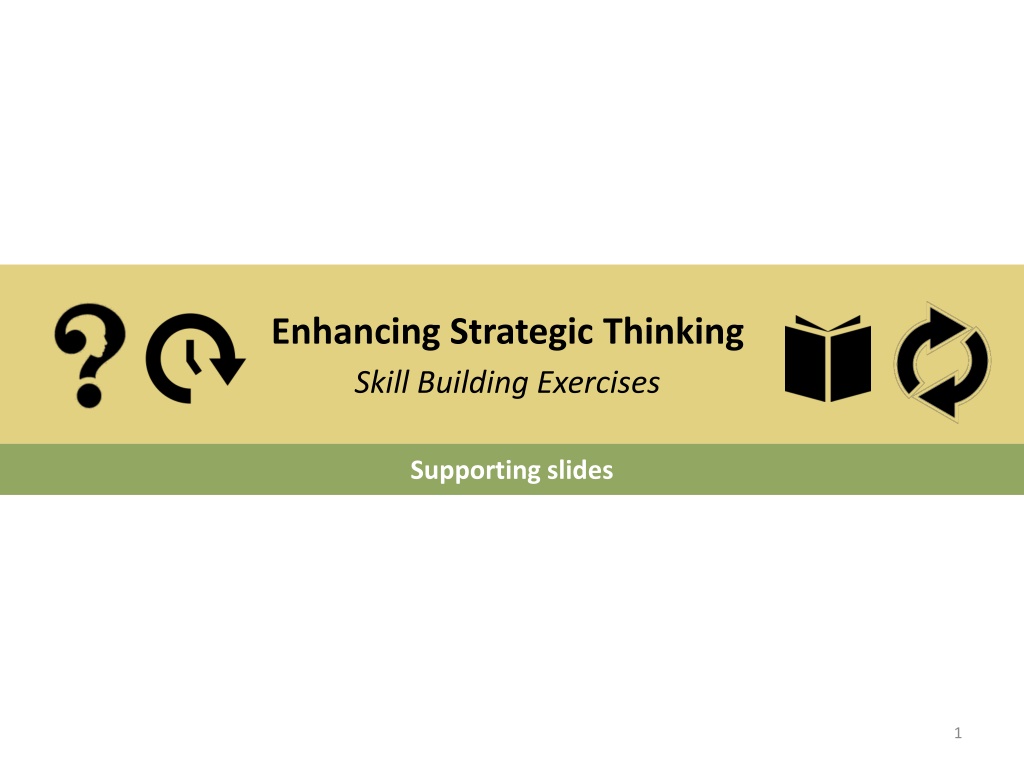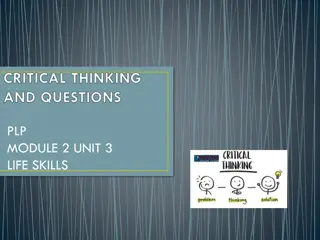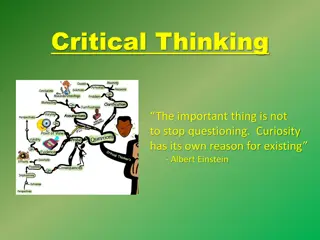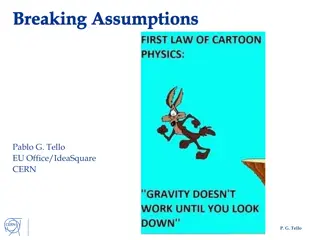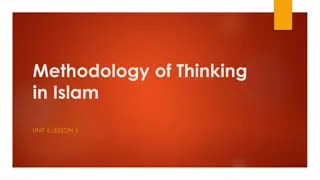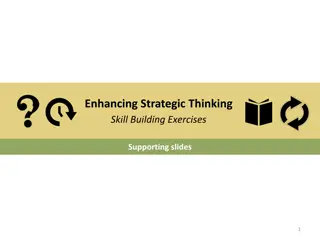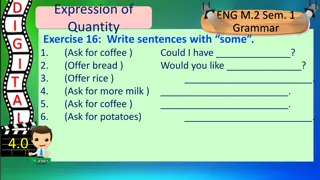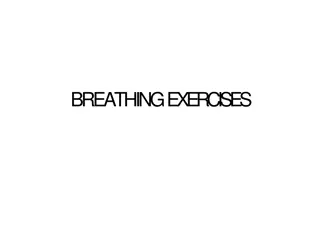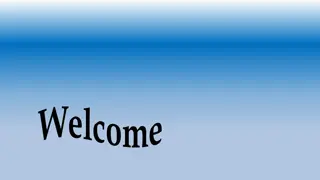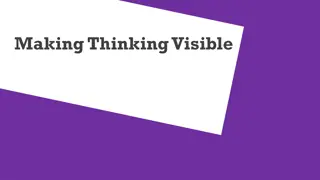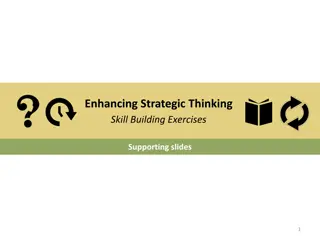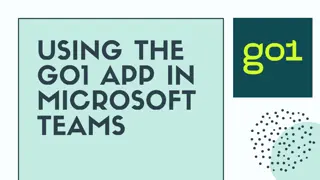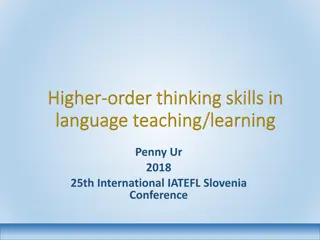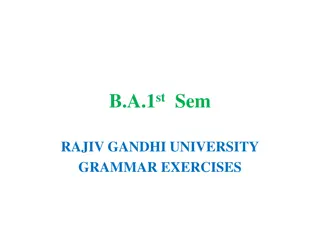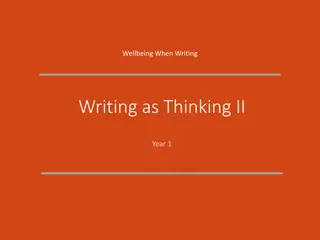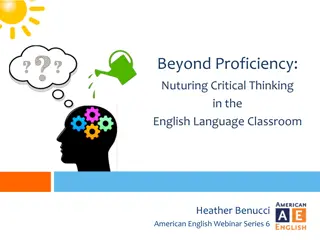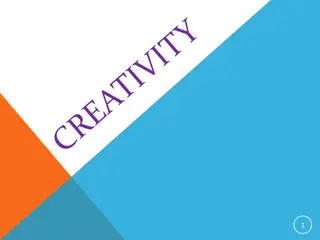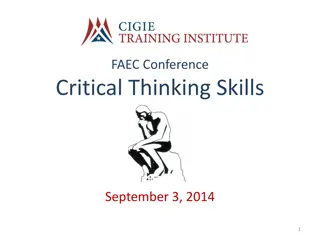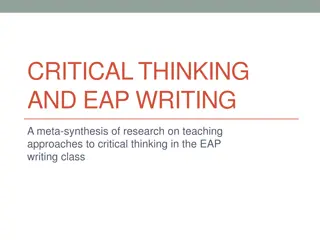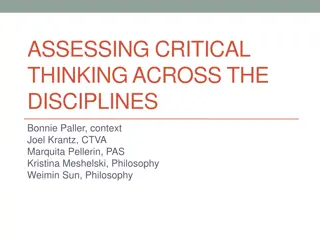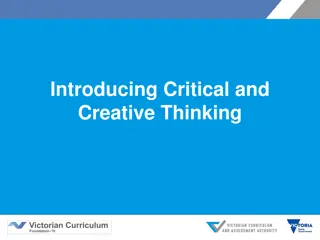Enhancing Strategic Thinking Skills Through Supportive Exercises
This presentation focuses on the importance of building foundational skills to enhance strategic thinking abilities. It provides context, exercises, and learning objectives for participants to develop competencies like critical thinking, information gathering, and learning. The content emphasizes the necessity for current and future Army leaders to think strategically and adapt to change effectively.
Download Presentation

Please find below an Image/Link to download the presentation.
The content on the website is provided AS IS for your information and personal use only. It may not be sold, licensed, or shared on other websites without obtaining consent from the author. Download presentation by click this link. If you encounter any issues during the download, it is possible that the publisher has removed the file from their server.
E N D
Presentation Transcript
Enhancing Strategic Thinking Skill Building Exercises Supporting slides 1
NOTE TO FACILITATORS The slides in this deck have been developed to provide the following to participants: 1) Context for the skill-building exercise including the importance of practicing foundational skills to become an effective strategic thinker 2) An overview of the exercise including the purpose, activities, and learning objectives 3) Brief tutorial facilitators may choose to adapt, add to, or re-arrange any portions of this slide deck to introduce the exercise to participants. Slides contained in the Background and Context portion of the slide deck (slides 3 10) appear in the slide decks for each of the four exercises. 2
CURRENT AND FUTURE ARMY LEADERS NEED TO BE ABLE TO THINK STRATEGICALLY Army leaders need to anticipate change, think long term, envision potential futures, and exploit opportunities to serve national interests Before Army leaders step into positions that require them to function as strategic thinkers and planners, they need to hone the building block skills that underpin strategic thinking Image credit: http://www.hawaiiarmyweekly.com/storage/2016/02/2378779-768x510.jpg 4
WHAT SKILLS ARE FOUNDATIONAL TO STRATEGIC THINKING ABILITY? Competency A Strategic Thinker continuously scans the environment seeks information from disparate sources suspends judgment and maintains an open mind considers other perspectives possesses advanced listening and research skills Comprehensive Information Gathering is a lifelong learner iteratively tests, reflects on, conceptualizes, and manages knowledge to gain insights on the environment continuously examines his/her own thinking Learning identifies the essential aspects of a situation questions assumptions and asks relevant questions seeks to identify meaningful connections and distinctions understands nuance considers the limits of data Critical Thinking 5
WHAT SKILLS ARE FOUNDATIONAL TO STRATEGIC THINKING ABILITY? (CONT D.) Competency A Strategic Thinker understands historical and contemporary contexts. recognizes patterns. forecasts possible futures. anticipates second-and third-order effects. has a long-term perspective. Thinking in Time generates creative and novel ideas, concepts, and approaches, independent of conventional norms. Innovative Thinking uses a holistic perspective of the dynamic and complex environment. identifies interrelationships and integrates disparate factors into a comprehensive whole. Systems Thinking 6
WHAT ELSE IS IMPORTANT TO STRATEGIC THINKING ABILITY? Competency A Strategic Thinker Has a solid foundation for strategic thinking based in: a broad general knowledge of many disciplines (e.g., geo-politics, world religions/cultures, economics, technology, sociology). knowledge specific to a strategic environment (e.g., local/regional customs, history, stakeholders). Knowledge Leverages the capabilities of others in a team or informal network (e.g., through cooperation, leadership, building trust, conflict management) to supplement his/her own strategic thinking. Collaboration Communicates candidly and effectively to gain individual understanding and move to the shared understanding required for strategy implementation. Is adept in the use of multiple media formats (oral, written, visual). Communicates well with diverse audiences that require tailored and persuasive messages. Communication Is intellectually humble. Accounts for his/her own natural limitations and biases related to emotion, perspective, and self-interest. Maintains respect for differing values and priorities. Emotional Regulation 7
STRATEGIC THINKING SKILL-BUILDING EXERCISES WILL HELP YOU BUILD SKILLS NEEDED FOR STRATEGIC THINKING. Exercises in this series include: Reflecting on Experience--provides practice in reflective thinking, learning from experience. Asking Powerful Questions--provides practice in questioning. Telling a Story--provides practice in systems thinking, synthesis. Envisioning Potential Futures -provides practice in thinking in time, strategic foresight. 8
THINK OF THESE EXERCISES AS COMPARABLE TO AN ATHLETIC DRILL. Professional basketball players don t just play a lot of basketball. They practice component skills ball handling, shooting baskets, rebounding, and footwork. Practicing these foundational skills repeatedly and over time is essential to becoming a skilled basketball player. Image credit: shutterstock.com 9
DEVELOPING STRATEGIC THINKING ABILITY ALSO REQUIRES TIME, PRACTICE, AND ATTENTION TO FOUNDATIONAL SKILLS. Doing any of the exercises once or twice will not transform you into a strategic thinker. They are analogous to the drills that athletes use to hone their skills. Developing advanced ST skills means repeatedly practicing the foundational skills necessary to become a great strategic thinker. The exercises can help you practice some of the (many) skills you ll need in order to become a skilled strategic thinker. Image credit: shutterstock.com 10
Overview Envisioning Potential Futures 11
WHATS THE PURPOSE OF THIS EXERCISE? Primary Purpose: To build your strategic foresight skills. Strategic Foresight Generating concepts of possible future alternatives based on attention to a diverse range of factors and their interactions. Thinking in Time Alternating between thinking about the past, present, and future. Secondary Purpose: To practice ways of shaping the future in the context of a scenario. Image credit: shutterstock.com 12
THE EXERCISE WILL ALSO HELP YOU PRACTICE THESE ADDITIONAL SKILLS: Questioning An active learning strategy used to understand problems, relevant factors, interdependencies, assumptions, and differing perspectives more deeply. Systems Thinking Recognizing and describing relationships and interdependencies among factors that might otherwise appear unrelated. Visualizing Creating and thinking in mental images. Sensegiving Communicating your understanding to others. 13
WHAT WILL I DO IN THE EXERCISE? Read a brief description of an emerging global hot spot Sketch your understanding of the problem, considering a range of factors Think back in time 5 years and describe conditions that existed then Think forward in time and describe alternative futures Consider possible courses of action to shape the future Reflect on the exercise and discuss with the group 14
WHAT MATERIALS DO I NEED? Participant Guide (provided by facilitator) Pen/pencil Notebook/pad of paper Image credit: shutterstock.com 15
WHAT WILL I GAIN FROM THIS EXERCISE? Appreciate the value of expanding your thinking beyond the present and/or near-term future. Recognize that current assumptions, decisions, and courses of action can have long-term implications. Recognize that thinking back in time (historically) can support your ability to anticipate how the situation may evolve into the future. Consider a range of factors (e.g., military, political, socio-cultural, religious, economic, physical environment, technological) and their interactions when making sense of a situation and anticipating potential futures. Create and present descriptions of potential futures. 16
WHY DOES FORESIGHT MATTER? Foresight is a key building block to developing strategic thinking skills. Involves thinking about how a situation might evolve into the future Requires attention to multiple factors -- social, economic, political, military, environmental, and technological trends and interactions. Allows us to generate approaches to shape the future. Enables us to set priorities and allocate resources. 18
WHATS HARD? Factors that may hinder foresight Army leaders typically face a host of immediate problems and the need to put out fires. oFocus on current and near-term problems can crowd out consideration of the longer-term future. Anticipating potential future scenarios means dealing with complexity. oRequires thinking holistically about multiple factors and how they might interact to affect future events. oCan be challenging to break silos. 19
WHATS HARD? Factors that may hinder foresight (Cont d.) The range of information resources we use to identify patterns and trends is often limited. oMay lead to an incomplete picture. oMay miss key trends and form incorrect interpretations. We tend to be overly optimistic in our predictions about future situations. We tend to focus on what is happening now and project that forward rather than imagining the wild card/unexpected disruption that could change everything. 20
TIPS AND STRATEGIES FOR ENGAGING IN STRATEGIC FORESIGHT Think backward in time in order to think into the future: Think about futures that are possible, not just the future that seems most obvious. Recognize that what matters most in the present, or what mattered most in the past, may not be what matters so much in future events. Image credit: shutterstock.com 21
TIPS AND STRATEGIES FOR ENGAGING IN STRATEGIC FORESIGHT (Cont d.) Recognize that whatever you come up with, you are likely to be off base. Go wide in your information search: oConsult a wide variety of sources--e.g., people of diverse backgrounds, varied publications, websites. oGather information about a range of topic areas--e.g., politics, economics, technology, social issues, etc. oConsider the perspectives of the sources you are using. 22
